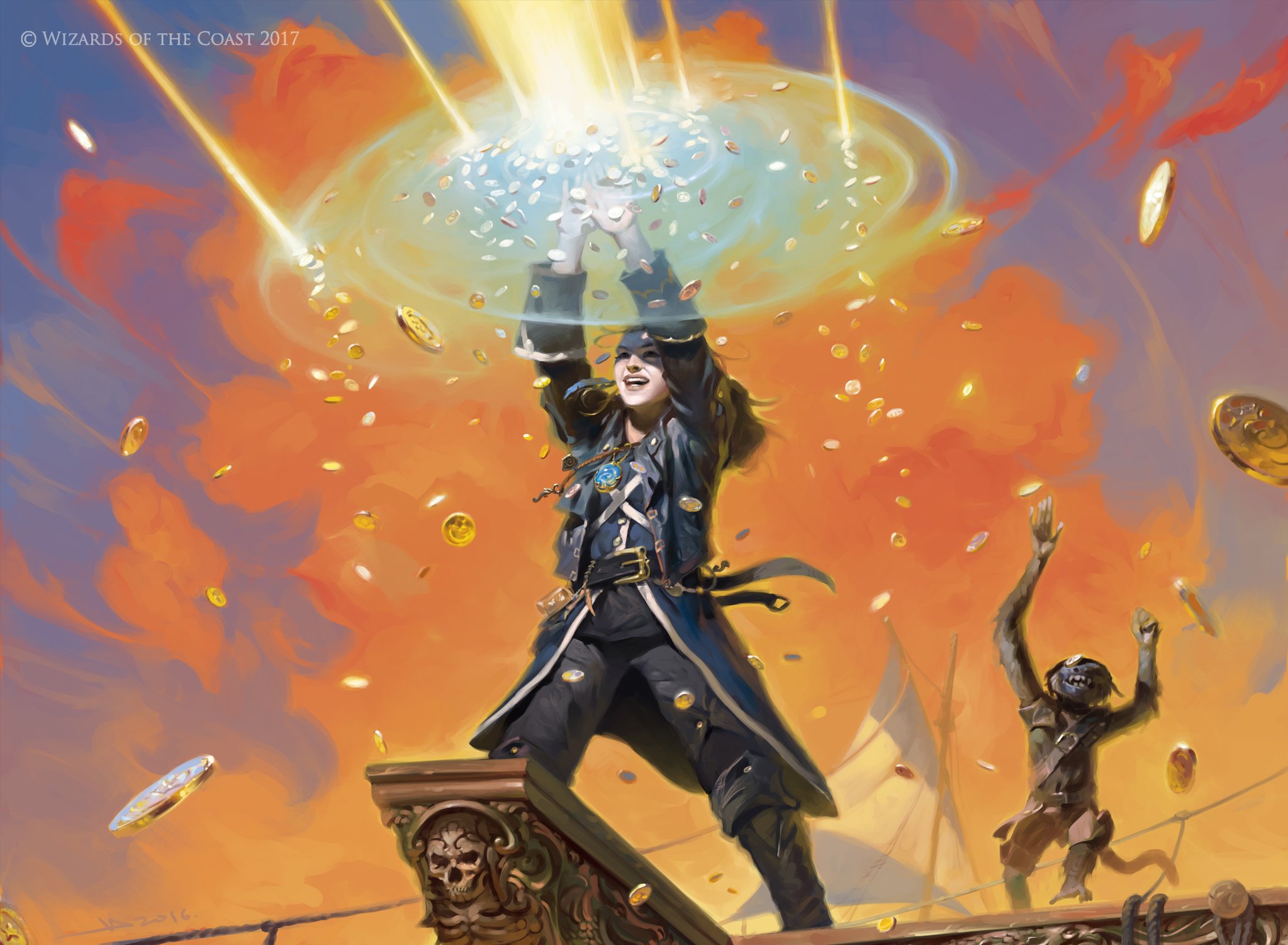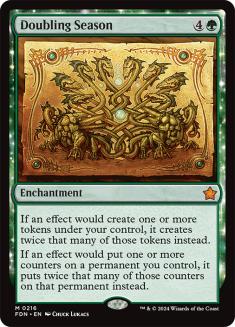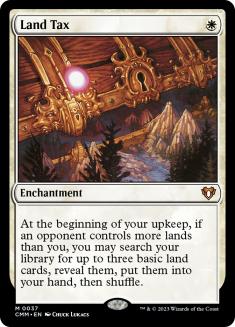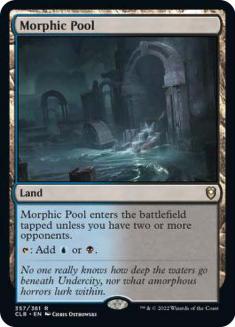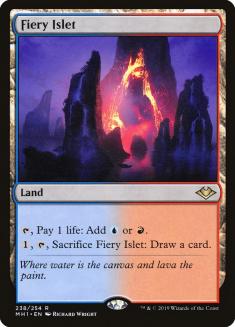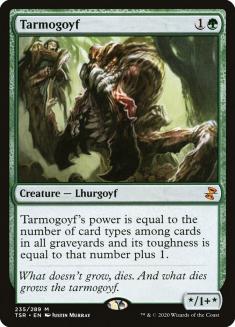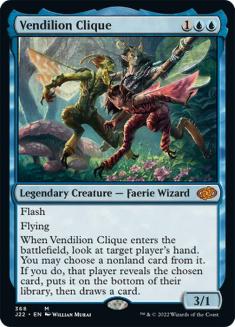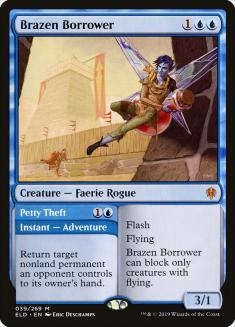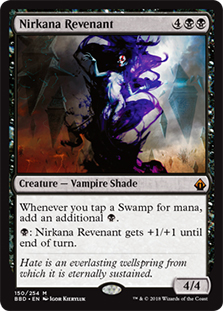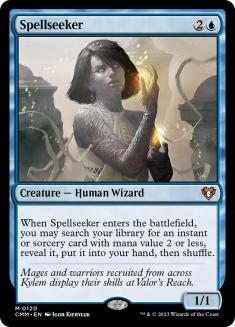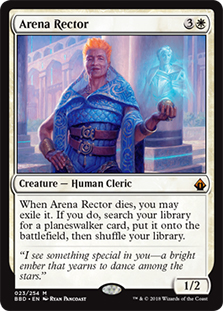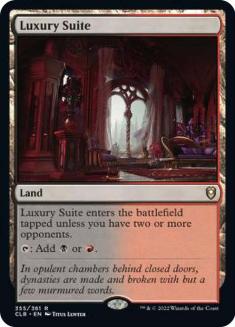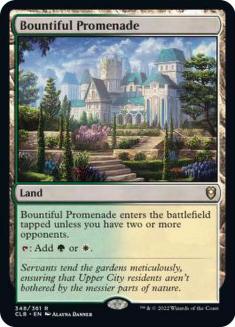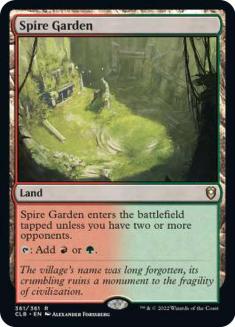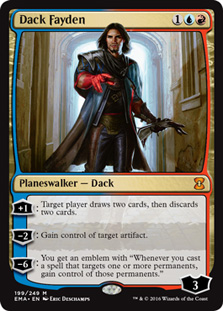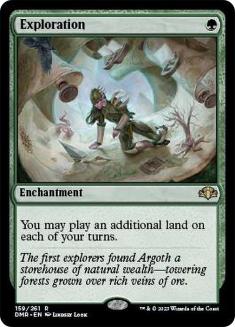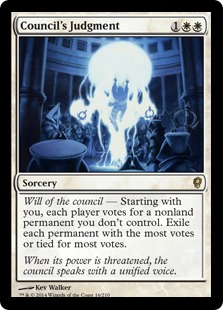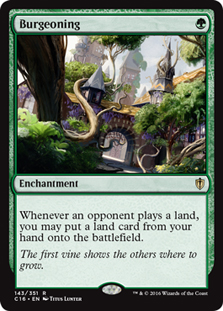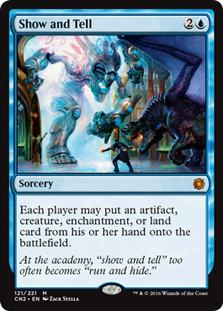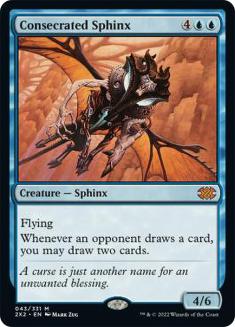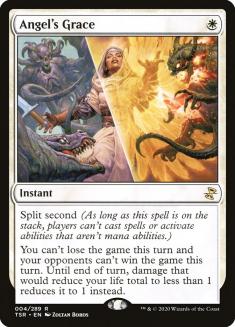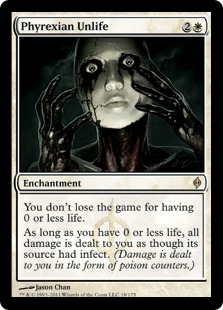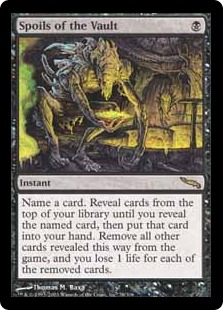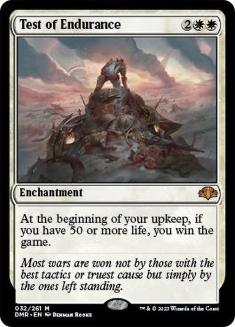This is the story of two very similar Magic sets.
The first, Battlebond, was the Wizards of the Coast (WotC) innovation set for spring 2018. It was a Commander-focused set, packed with powerful new casual mythics like Bramble Sovereign and high-octane reprints like Doubling Season and Land Tax. It was a big favorite of small-time speculators. Boxes were readily available in the $100 range for a while, and it wasn’t hard to crack packs and sell the singles at a small profit.
By the start of 2019, sealed Battlebond product began to dry up. By spring of that year, the price of a booster box had roughly doubled. Singles began trending upward, too. Morphic Pool, which pre-ordered for $15 before dropping as low as $5 during the first month of Battlebond‘s lifespan, was back up to $10 by the start of 2019 and was $15 again by April of last year. The staple land is now selling pretty steadily at $20. While not every card in the set has enjoyed such vigorous growth, the overall Battlebond index continues to rise.
The second set I want to talk about in depth today is Modern Horizons. WotC’s innovation set for Spring 2019 needs no introduction. It was one of the most-hyped sets in the history of the game, and if you wanted to buy a booster box of Horizons early on, you were likely paying at least $220 for the privilege. The price came down as 2019 wound to a close, though, and it looked like the set might leave print and start to spike around the same time that Battlebond did the year prior.
Nope. Modern Horizons booster boxes are readily available for $200 retail right now, and even that price feels a tad high to me. Some of the singles have seen wild price surges over the past year, but almost all of them are cheaper right now than they were when the set debuted. The overall Modern Horizons index is down, and the Horizon lands have proven particularly disappointing. Fiery Islet, which debuted at $40, has done nothing but drop in price for a whole year. You can pick up NM copies right now for $10 each on Star City Games.
So Battlebond was a great set to buy early, while Modern Horizons was a poor one. But why? Was it because the sets had different print runs? Different price points? Because they were aimed at different markets?
Or was it something else?
This puzzle is worth trying to solve, because we’re currently about two weeks into the lifespan of Mystery Booster WPN Edition. Magic’s newest innovation set has already had a fascinating impact on the market in its brief lifespan, with booster box prices starting low before spiking hard under a flurry of hype and speculation. But should you be buying up singles and boxes right now regardless, hoping this set will be the next Battlebond, or should you be staying away like it’s the next Modern Horizons? And for that matter, might Modern Horizons itself finally be a solid buying target?
Buckle up, because today is all about learning how to time the market for sets like these: when to buy aggressively, when to hold off, and when different kinds of cards tend to spike. Then we’ll apply what we’ve learned to Mystery Booster WPN Edition, and see if we can figure out what will happen with that particular set.
Print Run Size: The Biggest Short-Term Factor
I want to start by talking about print runs, because it’s the first factor that most people consider when trying to figure out how to time the market.
In this case, conventional wisdom isn’t wrong. The longer a set is in print, the greater the supply of key cards and booster boxes. The greater the supply of key cards and booster boxes, the longer you’ll have to wait for upward price movement.
Estimating even a vague sense of the size of a print run is harder than you might think, though. Aside from extremely uncommon cases like War of the Spark Mythic Edition, WotC doesn’t reveal their print run figures to anyone. I have no idea how many Ice Age boxes were printed, much less Throne of Eldraine or Modern Horizons boxes. There’s no way to really know for sure. (And no, Disreputable YouTube Man Who Claims to Know Things and Conveniently Also Sells Booster Boxes is not a reliable source.)
So where to begin? Well, the best place to start is by trying to figure out if the expansion you’re talking about is a limited print run set or a print-to-demand set. WotC produces both and they tend to have very different sales patterns.
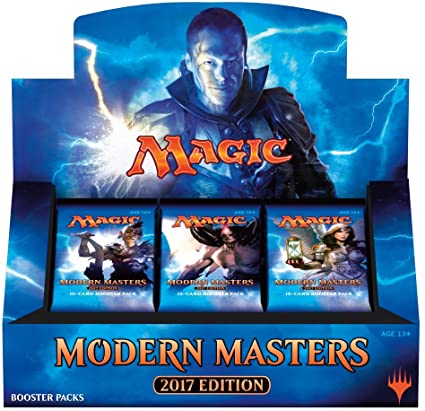
Limited print run sets are basically designed to be hard to get — think Modern Masters — and WotC generally just prints one wave of them before discontinuing the product. Distributors sometimes release these boxes to stores in multiple waves to create the illusion of greater supply, but once those boxes are gone, they’re gone.
Print-to-demand sets are just what they sound like. WotC produces a bunch of product at the beginning to satisfy the initial wave of pre-orders, and then it produces more product based on some combination (I assume) of projected demand and renewal orders. Then they’ll do it again. And again. And possibly again. They won’t stop printing the product until the projected demand falls below a certain threshold, or until they need the facility to print some other set.
Figuring out whether your set is limited or print-to-demand is a good place to start, but your analysis cannot end there. For example, Modern Horizons and Battlebond were both print-to-demand sets, while the lucrative Modern Masters 2017 and financial flop Eternal Masters were both limited print run sets. All four of these sets followed very different trajectories, so we’ve clearly got some more work to do.
Don’t Be Too Popular — Unless You’re a Limited Print Set
Battlebond was a popular set in the Magic Finance community, but the set was something of a flop out in the real world. Commander might be the most popular Magic format right now, but Battlebond‘s Two-Headed Giant-related marketing campaign probably made the set seem more niche than it actually was. Magic finance folks liked it because booster box prices were fairly low and singles prices were fairly high, but that was a result of players not wanting to buy packs despite needing some of the set’s best cards.
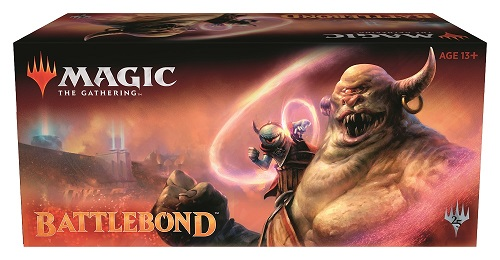
There’s no way to prove this without access to WotC’s internal numbers, but my guess is that Battlebond failed to meet expected demand and the printers were shut off a lot earlier than with most print-to-demand sets. That’s why boxes were pretty cheap toward the end of 2018, and gone by the start of 2019. After that, product was hard to come by, and prices begin to explode.
Modern Horizons probably sold quite a bit better. The marketing campaign was certainly a lot clearer, and WotC made sure to put a lot of essential new Modern cards (for good or ill…) in their flashy new set. My guess is that the available supply of Modern Horizons product will start to dwindle now, especially with Modern sales down across the board and WotC likely needing that printer for a future supplemental set. Of course, there are a lot of singles out there in the world already.
If you’re planning to invest in a print-to-demand set, then, you’re going to want to pick one that isn’t terribly popular so that you can take advantage of the smaller print run size, like with Battlebond. On the other hand, you’re going to want to hope for the opposite when it comes to limited print runs.
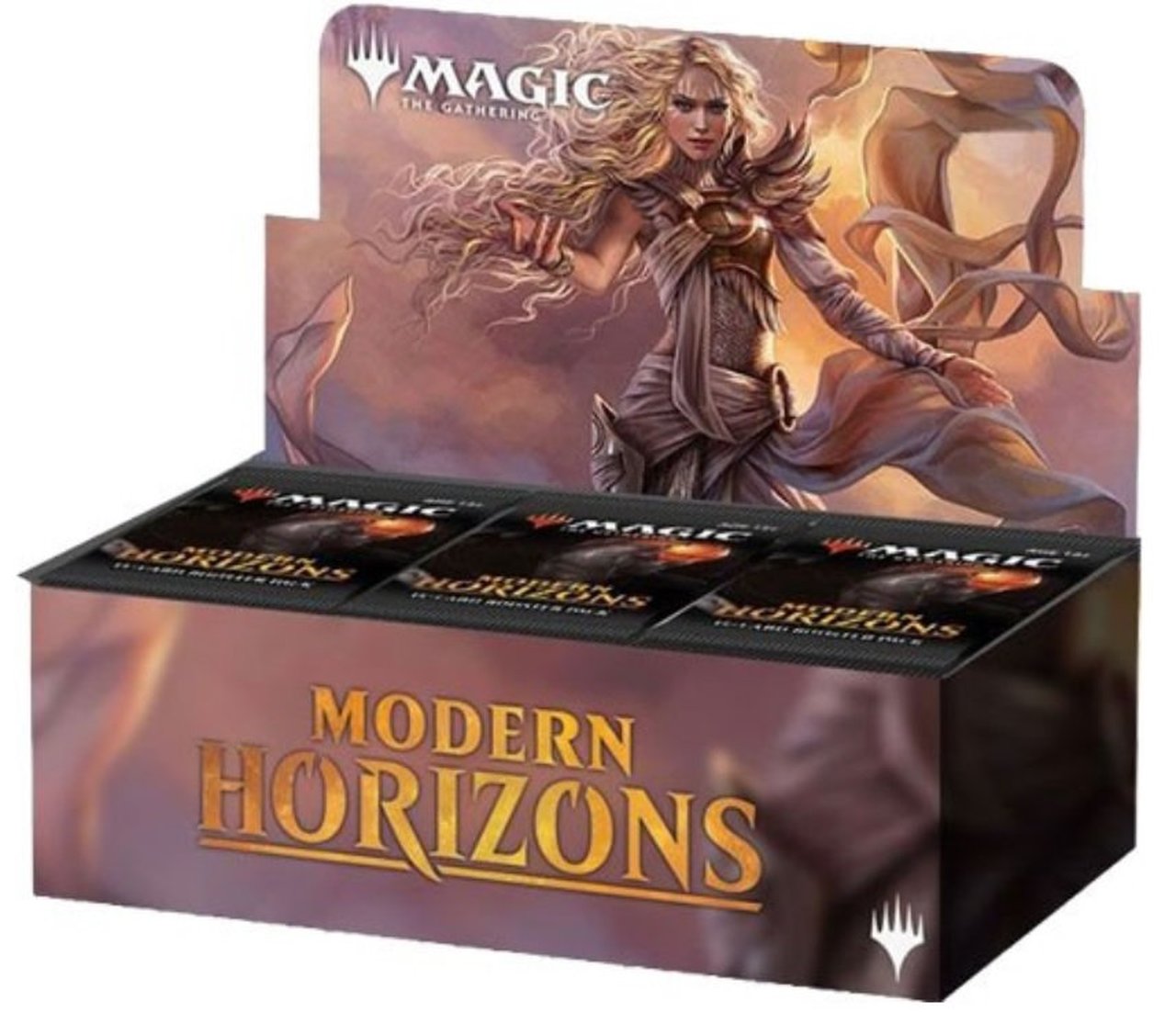
Think about it this way. If print-to-demand sets are like vintage toys, where the models that were less common initially tend to gain more value over time, limited print run sets are like convention exclusives. If they’re only printing 5,000 of something, then you’re going to want to invest in the thing with the highest overall demand, full stop.
This is the biggest reason why Modern Masters 2017 booster boxes rebounded so quickly while Eternal Masters booster boxes took several years to start getting frisky. A lot more people play Modern than Legacy or Vintage, and any set with enemy-colored fetchlands is always going to have a pretty broad audience. If you’re investing in a limited print run set and you’re looking for fast money, make sure it’s wildly popular from the start.
Commander Is a Rising Tide…for the Patient
Competitive metagames change. Standard changes the fastest, of course, but the “eternal” formats are hardly eternal in any meaningful sense these days. Certain cards are always going to be good — the fetchlands, Thoughtseize, Lightning Bolt, etc — but it’s interesting to look back at old Modern Masters sets and marvel at the cards that were considered key reprints back in the day. When Modern Masters 2013 came out, Tarmogoyf and Vendilion Clique were the set’s two highest-profile reprints. Doubling Season is currently more expensive than either.
Doubling Season has been a Commander staple since Day 1, and it’s still one of the format’s best cards. While Commander’s “metagame” has changed somewhat over the past few years, mostly due to power creep and WotC’s focus on printing cards with the format in mind, the best Commander cards are all pretty brisk sellers. Ditto for the format’s key niche cards, especially those from weird sets like Battlebond. These are the cards that have blink-or-you’ll-miss-it price increases from $3 to $20.
This is the other reason why Battlebond ended up being such a uniquely good set to stock up on. Between its niche single-printing Commander staples like Morphic Pool and its classic Commander reprints like Doubling Season, Battlebond was the perfect storm of low supply and high long-term demand. The same goes for the two Conspiracy sets, both of which have seen their booster box prices double over the past few years.
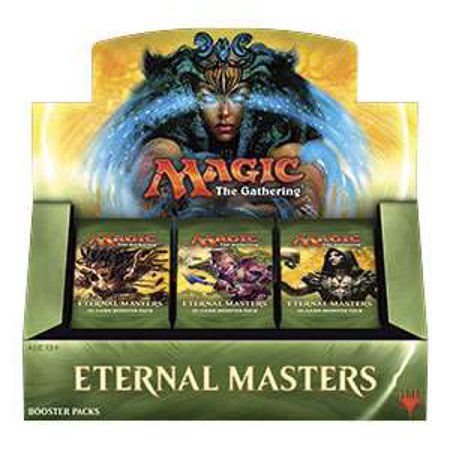
If you’re looking for long-term growth, this is the top factor to consider, even if your investment looks bad for a while. Remember Eternal Masters, that disappointing limited print run set? Booster boxes of that set currently sell for $450, in large part because the set is full of Commander staples like Mana Crypt and Sylvan Library. People just had to be patient for long enough, and their investment finally paid off.
How to Time Individual Card Buys
We’ve talked a lot about overall set trends, but what about individual cards?
I’m not going to spend much time covering cards in Standard-legal sets, because timing that market depends almost entirely on developments in the various competitive metagames. Nearly every other article I’ve ever written is about trying to figure that stuff out, and the best thing you can do is to keep apprised of the latest developments across Standard, Modern, and Pioneer. Cards go up in price when they see more play, and they drop in price when they see less play. You know the drill.
For our purposes today, let’s start by taking yet another look at Battlebond. You could make money buying booster boxes at retail for almost the entire duration of 2018, but what was the right time to buy singles?
Almost without exception, the key Battlebond reprints bottomed out almost exactly six months into their lifespan, in mid-December of 2018. They stopped crashing and became pretty accessible at or near their lows about a month after being reprinted, though, so really you had about a five-month buying window. Nearly every card was a buck or two cheaper at the end of this window, closest to the six-month mark, but many of them spiked pretty hard after that. Buying in slightly early would have mitigated the risk of missing out entirely.
The key new cards in Battlebond had a little more variance in their price movement, but most of them still bottomed out at some point between mid-December of 2018 and mid-February of 2019. These cards tended to lag a little more, with the lowest point of in the market converging a little closer to the seven month mark than the reprints, but most of them had started to spike by spring regardless. In both cases, buying in mid-December of 2018 would have been a good call.
The only major exceptions? Battlebond‘s rare land cycle, which hit their all-time low just one week after the set’s initial release. After that, they slowly started gaining value — week after week, month after month. They were the only cards in the set that consistently gained value throughout this initial release period, so anyone who was paying close attention had a shot to buy in somewhat close to their overall lowest price points.
Moving on to Modern Horizons, price trends had slightly more variance to them. Nearly every card hit what now appears to have been a false bottom in late August of 2019, just around the three-month mark. Then they started to spike a bit, peaking in the middle of October. Then…collapse. Nearly every card in Modern Horizons is at or near its lowest point right now, and the market doesn’t currently show any signs of recovery.
What happened here? Well, part of it might be supply-side — the increase in demand triggering another round of boxes being printed — but my guess is that these losses have more to do with the advent of Pioneer. Modern prices across the board dropped significantly toward the end of 2019 and in early 2020, primarily because everybody switched their focus to Magic’s newest eternal format. That shift won’t be permanent — going forward, Modern and Pioneer with both ebb and flow at different points during Magic’s calendar — but it’s hard to predict a Modern rebound in 2020 when the near-term future of tabletop Magic still just a giant question mark. If we weren’t living through such uncertain times, I’d likely call Modern Horizons singles a pretty strong buy right now. Instead, I’m going to continue holding off until we get a sense of when MagicFests and such will return.
Building a Pattern
One set might be a data point, and two sets might form a line, but we’re going to need more information before we can call anything a pattern. Let’s take a look at some of WotC’s other offbeat sets and see what else we can learn.
If we’re looking for confirmation that buying in at the six-month mark is good, the first Conspiracy set seems to line up pretty well with our hypothesis. Most of the cards in that set either started spiking around the eight- or nine-month mark (Dack Fayden, Scourge of the Throne) while others (Exploration, Reflecting Pool) puttered along for another twelve to eighteen months, gaining 20-30% in value before eventually making a run. The only card that would have been a lousy buy around the six-month mark was Council’s Judgment, and that has more to do with competitive play patterns and the erosion of Legacy prices than anything else.
What about Conspiracy: Take The Crown? That’s a little more complex. A few key cards do follow that six-month pattern — Burgeoning and Queen Marchesa, for example — but many do not. The set’s two best Commander cards, Selvala, Heart of the Wilds and Expropriate, were never cheaper than at their initial release. Ditto for key reprints Phyrexian Arena and Birds of Paradise. On the other hand, Berserk took a full eighteen months to bottom out, while Show and Tell has literally kept dropping for four straight years.
What happened with this set? I think a lot of people initially underestimated the demand for key Commander cards, both reprints and originals, while overestimating demand for assumed Legacy staples. Legacy has fallen off quite a bit since Conspiracy: Take the Crown was released, so demand for cards like Show and Tell, Berserk, and Sanctum Prelate is a lot lower than most of us assumed it would be back in 2016. Take this into consideration when making your spec buys, as well as when evaluating demand for new sets.
What about limited printing sets, like Iconic and Ultimate Masters? Let’s dip into those for a quick look.
Iconic Masters is a bit of a mixed bag. Most of the key Commander cards, like Consecrated Sphinx and Sheoldred, Whispering One hit their lows about three to four weeks into the set’s lifespan. Ditto for many of the Modern staples, like Thoughtseize and Horizon Canopy. The rest of Iconic Masters didn’t bottom out until the following December, though, which lends some credence to the idea that seasonal trends matter a lot when analyzing this stuff. Mid-December tends to be the best time to buy cards regardless, so a lot of bottoms happen around then.
Masters 25 seems to help cement this idea. While various cards in that set ebbed and flowed as the Modern metagame shifted, the majority of staples hit bottom during the following holiday season, about eight-and-a-half months after being released. If you wanted any of the Commander staples from this set, mid-December would have been the right time to buy.
Lastly, Ultimate Masters seems to have had too small a print run for the market to have been affected all that much. None of those staples really dropped in price due to the set’s release, though they’ve made gains and losses since then based on the various eternal metagames.
Drawing Up Our Plan
The patterns that emerge from all of these sets seem somewhat discordant, but we actually do have enough data to put together a meaningful set of heuristics that should let us time the market pretty effectively going forward.
First, operate with the baseline assumption that most cards from non-Standard sets will come pretty close to hitting their overall lowest price about three to four weeks after the set hits shelves. This is a pretty reasonable time to buy in regardless. If the price keeps dropping, expect it to hit an actual bottom in mid-December — whether that’s four months away, six months away, or nine months away.
If the price starts gaining at the three- to four-week point, however, then you should buy in ASAP. Very few cards start gaining at this point without continuing to gain ground throughout the rest of the year.
The exceptions to this rule mostly involve the set’s highest-priced, most-hyped cards — especially if they rely on Legacy play. These cards will take much longer to hit bottom and much longer to recover, if ever. If you’re uncertain, avoid these cards entirely.
Lastly, expect most Commander cards to eventually reward your patience. It may take three or four years, but powerful casual staples almost always rebound. This could change at some point — once upon a time, I said this about Legacy cards — but I don’t see an end to that gravy train yet, not even considering the state of the world right now.
Applying These Lessons to Mystery Booster WPN Edition
The biggest problem with speculating on the future of Mystery Booster singles is that we have no idea whether the set is print-to-demand or not. Some folks in the community have made pretty decisive remarks about its status one way or the other, but I’ve yet to see their assertions verified by any actual sources within WotC. It’s true that most sets are print-to-demand unless explicitly stated otherwise, but Mystery Boosters have always been sort of weird, and most distributors have been sold out of boxes for days now with no idea if or when they’ll get more. We’re all in the dark on this one, at least for now.
To that end, buying singles now seems pretty reasonable. If this is a limited release, prices will probably start to recover pretty quickly and you’ll be glad you bought in early, while there was still some confusion. Selvala, Heart of the Wilds is usually $40+, but you can snag a Mystery Booster copy now for $28. That price tag won’t last if the set doesn’t get a major second wave of product.
Assuming we do get a second (and a third, and maybe even a fourth) wave of Mystery Boosters, buying in over the next few weeks is still unlikely to be a bad idea. These cards might drop a little further over the coming months, and Selvala might end up in the $22-$25 range by December, but $28 will still seem like a pretty good deal once we take a look at the overall price charts in 2022 or so. Granted, the current state of the world economy might have something to say about all of this, but assuming we’re all playing paper Magic together this winter, you’ll be glad you bought in now. If you’re in the market for any of these cards, go take a look.
This Week’s Trends
It has been a week.
With social distancing requirements setting in and “shelter in place” orders going out around the country, Magic finance hasn’t exactly been at the forefront of anyone’s minds. The stock market is tanking, unemployment is spiking, stores are closing for weeks or months, and we don’t know when normal life is going to resume — and what it will look like when it does.
Magic prices are dropping a little, but the Magic index doesn’t look like the Dow Jones Industrial Average right now, thank goodness. Most people are busy thinking about other things, and it’s a whole lot harder to sell your Magic cards than your stock shares. My guess is that most people will do whatever they can to hold onto their decks and collections for now, but it will become a buyers’ market if we’re all stuck at home for months on end. The lack of tournaments and need for instant income will compound on itself.
Beyond that, I’m still exactly where I was last week — at a loss for the information necessary to tell you how bad things are going to get. We’re still well into uncharted territory with COVID-19, and that’s about all I can say. Part of me believes that we’ll all be back to normal by midsummer, and another part of me believes that the world is changing in vast and immeasurable ways right now. I promise I’ll do what I can to give you the most accurate information and analysis as I can for the duration of this crisis and I can’t wait to see you all at the next big event on the other side.
Moving on to more specific movers and shakers, there were a few real-world spikes this week. It’s not all doom and gloom! Angel’s Grace roughly doubled in price this week, both as a soft answer to Thassa’s Oracle decks and as a combo piece in a new Esper Inverter deck. This version of Dimir Inverter uses Angel’s Grace and Phyrexian Unlife alongside the Inverter combo and other juicy cards like Spoils of the Vault and Wishclaw Talisman.
Creatures (8)
Planeswalkers (4)
Lands (19)
Spells (29)

I’d like to see this version put up results before I fully buy in, but that’s going to be limited to Magic Online (MTGO) match data for the foreseeable future. At any rate, the other combo pieces are pretty cheap right now, and there hasn’t been any price movement for Phyrexian Unlife and Spoils of the Vault yet. If you’re looking for potential spec buys while everyone else is distracted, here you go.
Also up this week: Test of Endurance, a low-supply alternate win card from way back in Judgment. There have been a number of good “lifegain matters” cards printed recently, including in Theros Beyond Death, so it’s likely that this spike is due to a buyout immediately following a period of slow and steady Commander demand. As with all spikes like this, selling into the spike is usually a pretty good call, and you should take advantage of this demand window while you can.

